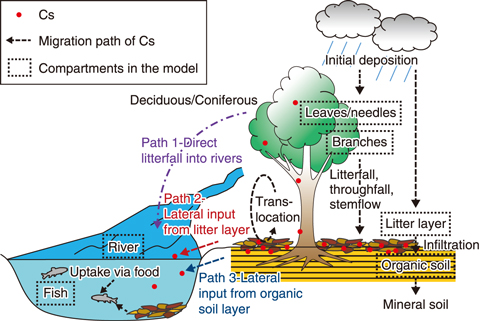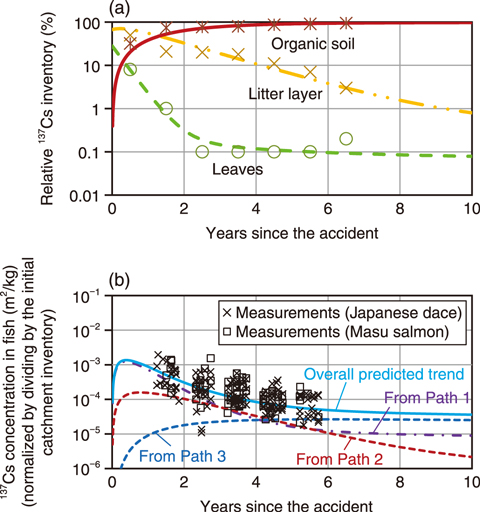
Fig.1-18 Schematic of Cs migration in forest and transport to fish including compartments considered in the simulation model

Fig.1-19 Calculated and measured 137Cs concentration in fish
The Radiocesium (Cs) concentration in freshwater fish caught in Fukushima Prefecture is decreasing with time, allowing shipping restrictions to be lifted. Cs taken up by fish living in mountainous streams is considered to come from forests (Fig.1-18). However, it has been unclear why the Cs concentration is decreasing more rapidly in fish than in the forest and from where in the forest Cs comes into rivers.
In this study, the migration pathways of Cs from the forest to the fish in mountainous streams were analyzed using a developed model coupled with accumulated environmental monitoring data. The model, shown schematically in Fig.1-18, considered leaves/needles, branches, litter layer, organic soil layer, river water, fish, etc., as compartments. At first, the transfer rates of Cs from one compartment to another (e.g., leaves to the litter layer) were determined based on field investigations. The time evolutions of Cs inventories in all compartments were then calculated stepwise. The simulation was then used to clarify that the decrease in the Cs concentration in the fish was linked to the migration of Cs in the forest, including the transport of Cs from the tree canopy to the litter layer and from the litter layer to the underlying organic soil (Fig.1-19). More specifically, Cs was transferred to fish via a combination of three pathways, as shown in Fig.1-19(b): 1) direct litterfall into the river and its subsequent breakdown, 2) lateral transfer of dissolved Cs derived from the litter layer into the river water, and 3) lateral transfer of dissolved Cs derived from organic soil into river water.
The Cs concentration likely decreased more quickly in fish than in the forest because of the faster decrease of Cs in the leaves/needles and litter layer (Fig.1-19(a)). This resulted in a decreased Cs supply via paths 1 and 2 (Fig.1-19(b)). The contribution from organic soil (i.e., path 3) with a high Cs content will likely increase with time. In the organic soil layer, Cs gradually migrates deep underground and is adsorbed on mineral soil. Thus, understanding the behavior of Cs in organic soil is key for any future predictions of the Cs concentration in freshwater fish living in mountain streams.
The clarification of the mechanism of the changing Cs concentration in mountain stream fish may be useful for lifting shipping restrictions on wild freshwater fish caught in Fukushima Prefecture.
(Hiroshi Kurikami)